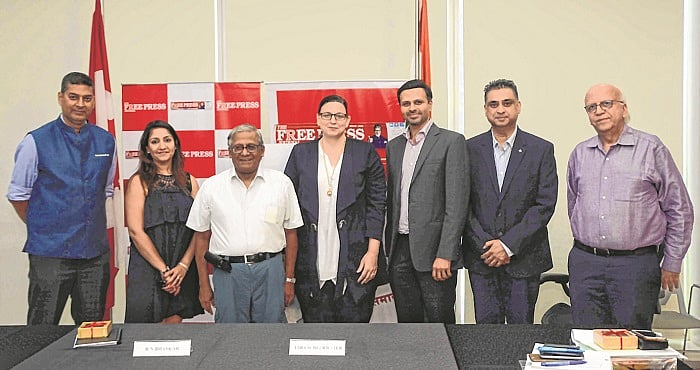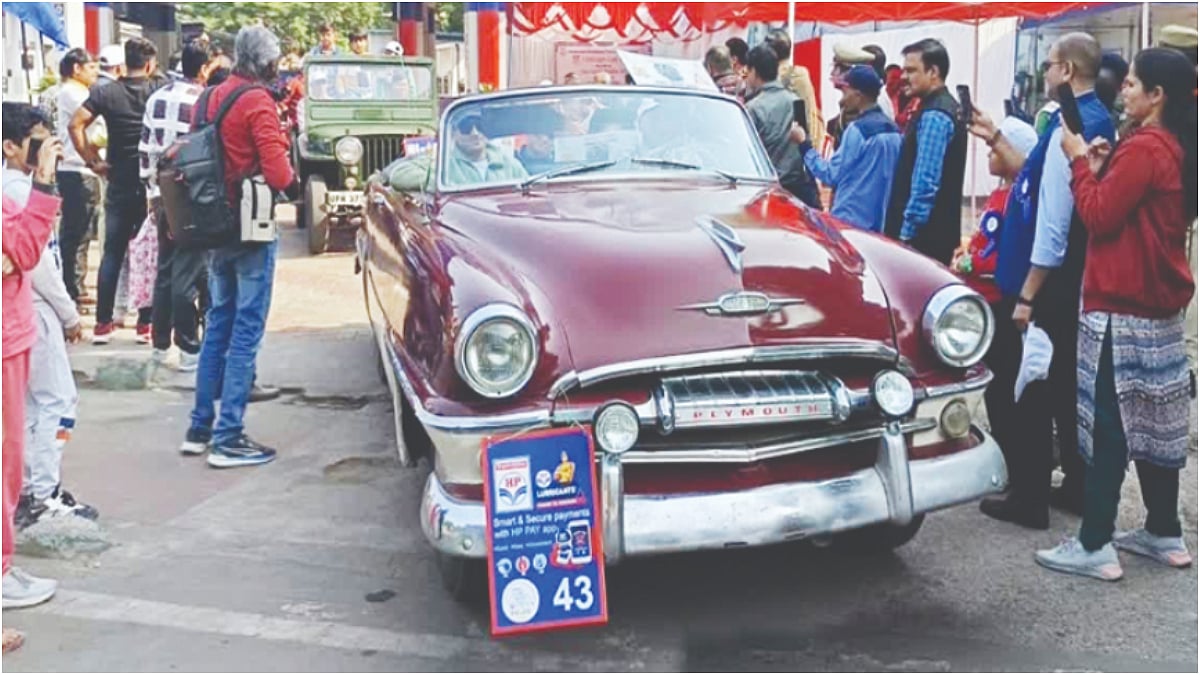World Tourism Day has consistently been a day where travel ministries of countries around the world as well as private sector organisations, encourage tourism traffic as well as promote domestic and international travel among their own citizenry. To celebrate this day, FPJ organised a panel discussion titled ‘Tourism in and with India’ at the Consulate General of Canada, Mumbai. The participants of the discussion was Carl Vaz, CEO and Strategy Director, Destination Canada; Sheetal Munshaw, Director, French Tourism Board; Sherry Bhatia, VP, HRAWI and Romil Pant, SVP, Leisure travel, Thomas Cook (India). Acting Consul and Senior Trade Commissioner at the Canadian Consulate, Tara Scheurwater, delivered the welcome address. The discussion was moderated by R N Bhaskar, Consulting Editor with editorial support from Pankaj Joshi.
TARA SCHEURWATER: Since 1980, under the aegis of the United Nations World Tourism Organisation, we celebrate World Tourism Day on September 27 each year. India, traditionally a minor source of interest in terms of tourism, is now growing rapidly. Incidentally, Canada this year is being promoted as a destination of choice. You can see our air capacity continues to improve and the network of direct flights keeps increasing. The idea is that tourism is one of the ways in which people come together, cross-cultural exchanges happen and a global citizen view is evolved.
KEENNESS TO ATTRACT INDIAN TRAFFIC AND THOUGHT EVOLUTION
CARL VAZ: There is no doubt that we, and indeed the travel industry globally, are keen to track and attract the Indian traveller. With regards to World Tourism Day, we would be involved in some corporate social responsibility activities as part of promoting the day, including team interactions at orphanages and old age homes. India is an
evolved market and the global tourism industry is doing their best to lure them. Indians are present across all segments – a short-haul holiday, a medium-haul trip and a proper long-haul vacation.
ROMIL PANT: Our power as a spender is rising, year after year. I would say that our customers are in the top five bracket worldwide in terms of spending. We are today talking of an Indian customer base which is up there in numbers and in spend as well. As travellers, we will continue to push the envelope beyond the current experience and location options. We will continue to demand new places and not just the regular places. Today, the Indian traveller’s heft has ensured cuisine being crafted in most parts of the world for a multiple variety of tourists from India.
SHEETAL MUNSHAW: For France, every day is Tourism Day. We are the country which received maximum tourists. That itself keeps the bar high for us. Be it global geopolitical conditions, economic affairs, even the demographics, emerging tourism source markets – the industry profile is changing constantly and we have to keep raising our game. So far as India as a source market is concerned, we have seen rapid growth in the last few years, which has indeed been overwhelming. From a figure of 3, 65,000 tourists in 2014, India sent across 6, 00,000 tourists to France in 2016. That is mind-boggling, more so when you consider the evolution side by side in terms of profile, types of tourists, even the regions from which they came. Total global arrivals in France in 2017 were 87 million (Paris alone has 24 million), so at 6, 00,000 we believe the Indian market represents immense potential.
PANT: One major advantage for Indian tourists is that they are acknowledged everywhere they travel. Food habits, walking on the road, idiosyncrasies – all these are given but there is no issue related to law and order. Globally, many countries appreciate this aspect and acknowledge the importance of Indian tourists from a trouble-free viewpoint.
Today India is recognised as a nonmonolithic, multi-faceted culture. Small towns are sending us travellers with diverse experience expectations. In terms of cuisine itself Southern food is in great demand, and in terms of people, those from Gujarat and Bengal are fastidious about what they will eat. North and West cuisines are totally different. All good destinations today try to satisfy these diverse requirements. Regarding Indian idiosyncrasies, other groups are way more eccentric and managing them – for travel planners, activity managers and the restaurant trade – is way
more challenging.
The thing to understand is not to equate increase in travellers with transactions, because the same target travellers today are looking at trips of threefour days for small weekends, six-eight days for small vacations and 15 days or so for the school term vacations. While some of these would overlap with trips to neighbouring nations, a good part of the smaller trips would be domestic by default. If you see, the number of passport holders also has to go up, which will take time, and then the overseas trips will be much more in proportion. Even accounting forage-wise break-up, the multiplicity factor of leisure tourism cannot be ignored.
INFRASTRUCTURAL CHALLENGES AND ROLE OF LOCAL BODIES
SHERRY BHATIA: Our association (Hotels and Resorts Association of Western India), established in 1951, is an industry platform for interaction with the authorities. We are responsible for the geographic territories of Maharashtra, Gujarat, Goa and Madhya Pradesh, with the adjoining Union Territories and have around 1,300 members. Our recent endeavours have seen a reduction in the Goods and Service Tax and the initiation of the food safety security initiative. Another area where the association is active is in the single-window clearance initiative. To open a business in this sector, one would have to get around 100 separate permissions which we have got down to 30. This is satisfying but we are still working with the Government to optimise it further.
PANT: On the inland side, constraints are much widespread and challenging. The accommodation capacity, the inland infrastructure (roads, railways), the limited number of tourist spots which can take traffic and provide a good experience and then there are the regulatory and environmental issues which do cramp the potential to an extent.
BHATIA: Inbound tourism does face approval challenges no doubt about it, but our association’s job is to work with the government and tell them the problems. Things no doubt are moving but there is always work in progress. Look at Maldives where properties are actually built on the ocean, against which we are told to build 500 metres from the coastline. Again, the city of Mumbai itself has seven to eight ongoing metro projects which will do wonders in future but do clog up the traffic at present.
Against that, the positives are that this city can provide accommodation priced from Rs 100 to right up to Rs 20,000 a night which speaks of diversity. Today, international inbound tourism is from those who have studied this country and love the bouquet it offers – temples, forts, wildlife sanctuaries, mountains, beaches. Our publicity activities have to go miles. Another issue is that India tends to be a bit more expensive compared to other South East Asian countries – both in currency terms and other factors that impact tourism. Adding to it is the investment in properties which is pretty high.
MUNSHAW: Tourism as a GDP contributor and employment generator needs no mention. We aim at cultural exchanges to better the whole tourism experience. France in that way is associated with a lot of different cultural niches. For instance, the mention of Champagne or Bordeaux as a place evokes expectations different from Paris or Nice or Toulouse. This is what we call promotion of signature hallmark destinations. Another method of promotion is through centres of excellence. Within tourism, we cater to gastronomy and promote French cuisine as a theme for global travellers. Gout de France, celebrated on March 21, is celebrated worldwide by more than 1,000 chefs who commit that day to French cuisines. We have staple attractions – stereotypes if you want to call them so – and we have to leverage and scale them up.
PANT: Now we come to issues impacting Indian tourists and the uppermost of them would be visas. A 48-hour visa availability becomes a vital matter, and it is no coincidence that many Indians go to Paris, just because it is possible to get a visa in a short time frame. On top of that, the Schengen visa means you can go to other parts of Europe as well. That is a major convenience. On the industry side, the product manager is a seller and whichever product (read destination) supports him the best is what he can push for. The support could be not only in terms of location attraction, culture, cuisine but also in terms of connectivity, visa ease, and related services. It is not coincidental that many of our itineraries start at France. Our itineraries are growing for Europe, USA and Canada. However, USA and Canada visas can take two months and in comparison the Schengen visa is a boon to the multi-country tourism plan.
SCHEURWATER: Canada’s challenge would be different. It would be to go beyond the stereotypes. We are known for raw nature experiences, but we aim to offer urban-centric experiences as well. We aim to promote hikes and outdoor activities, but alongside we would also promote the Toronto Film Festival and similar events in an urban milieu.
MUNSHAW: There are some complaints about the short duration of the Schengen visa, but you must bear in mind that by offering a Schengen visa, you become responsible to borders of other countries as well.
SERVICING THE INDIAN TRAVELLER AS A KEY BUSINESS PRACTICE
PANT: My experience in travel is a bit less, around eight years and my biggest takeaway as of date is the clear dearth of trained professionals at the level required. In our growing-up times, travel for most was not the first or even second choice in career. Given that, the quality of people associated with the sector would be mixed at best. This makes proper training a critical requirement. We at Thomas Cook are initiating training programmes across different durations (one day, three-five days) next year and that would kick off on World Tourism Day 2019. This is apart from our currently active centre of learning which produces well-trained professionals every year.
VAZ: In 2017, around 2, 40,000 travellers came from India to Canada and the figures up to May 2018 show a 50 per cent comparable year-on-year growth. We have direct flights from Delhi touching the East and West coasts. From Mumbai, Toronto on the East coast is direct and then some go onward to Ontario and up to British Columbia. Our geographic challenge is to take them deeper, extend the tourist circuit. According to me, the second challenge is to get more Canadian tourism stakeholders interested in India and to get them to be more active.
SCHEURWATER: From our side, we need travel agents to take more responsibility as ambassadors for the sector and the country. They must guide the traveller segment. For instance, we have online application and processing, which enables applicants to keep the passport with them. This is of great help if they have to apply for multiple visas, and they can get into our embassies overseas to complete the process and obtain their Canada visas. As the traveller contingent gets more internet-savvy, our visa processes will have more value for them. But till then, we would appreciate the travel agent contingent giving out proper guidance.
PANT: The online service works very well indeed and small-town people, travellers or industry professionals, will be immensely benefited. I often tell my team that a product seller (sales officer) has to understand destinations – Japan to Canada, to New Zealand – then understand the local cuisine, attractions, activities, then the visa processes, and have to shoulder all this by himself. Those nations who understand that simplicity is needed (for the seller to sell), will learn the trick to go ahead in the race to attract tourists.
EDUCATION AS A TOURISM CATALYST
SCHEURWATER: Canada sees a lot of overseas students coming in, and invariably some tourism follows the student population, both by themselves and by their families who follow them now and then. If you see education in Canada, the most students come traditionally from China, Saudi Arabia and Korea. However, India as a source market is also coming up rapidly. Right now we estimate around 1, 30,000 students from India and these are for long-term study courses. The ones coming over for brief courses, with a lot of travel factored into the course duration, are not calculated and those also give our tourism sector figures quite a boost.
VAZ: India today has diverse tourist profiles. Our profile is the 25-44 group and 55-64 group, both with stable high incomes. In terms of education, Canada is growing to be a hub. And apart from the student-parent pull, we also believe that advocacy on the part of the students is also going to be a key driver in the future.









